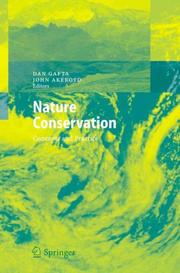| Listing 1 - 2 of 2 |
Sort by
|

ISBN: 1281351431 9786611351434 3540472290 3540472282 3642079938 9783540472285 Year: 2006 Publisher: Berlin ; New York : Springer,
Abstract | Keywords | Export | Availability | Bookmark
 Loading...
Loading...Choose an application
- Reference Manager
- EndNote
- RefWorks (Direct export to RefWorks)
8 SHORT REVIEW AND CONCLUSIONS OF THE INTERNATIONAL SYMPOSIUM (“Conceptions and Methods of Nature Conservation in Europe”, Cluj-Napoca, September 16–19th, 2004) 1 1 2 Vasile CRISTEA , Dan GAFTA , John R. AKEROYD 1. “Babe -Bolyai” University, Department of Taxonomy and Ecology, Republicii str., 42, 400015 Cluj-Napoca (ROMANIA) 2. Plant Talk, Lawn Cottage, West Tisbury, Salisbury, Wiltshire SP3 6SG, UK 1. General review of the symposium Organized by the Chair of Taxonomy and Ecology of the University „Babe -Bolyai” (Cluj-Napoca, Romania), in co-operation with the Romanian Society of Phytosociology and the International Federation of Phytosociology, this international symposium was dedicated to Prof. dr. h.c. Franco PEDROTTI th (University of Camerino, Italy), on the occasion of his 70 birthday. Drawn from four continents, the 84 participants (of whom over 50% were young people under 35 years old) represented 12 countries: Belgium, Bolivia, Brazil, Germany, Italy, Japan, Poland, Romania, Russia, Slovenia, UK and USA, thus covering a large part of Earth’s bio-geographical regions. The opening ceremony took place in the University’s imposing Aula Magna and included two welcome speeches on behalf of the Rector and the President of the Nature Monument Committee, a Laudatio to Prof. F. Pedrotti and a short folk music recital. The symposium programme was composed of two plenary sessions, four short communication sessions (divided into two sections: A – General aspects of nature protection; B – Nature conservation in practice) and a poster session. The seven plenary lectures, presented by R. Pott (Hannover, Germany), E.
Nature conservation. --- Conservation of nature --- Nature --- Nature protection --- Protection of nature --- Conservation of natural resources --- Applied ecology --- Conservation biology --- Endangered ecosystems --- Natural areas --- Conservation --- Environmental protection. Environmental technology --- Nature Conservation. --- Biodiversity. --- Biological diversification --- Biological diversity --- Biotic diversity --- Diversification, Biological --- Diversity, Biological --- Biology --- Biocomplexity --- Ecological heterogeneity --- Numbers of species
Book
ISBN: 3030372421 3030372413 Year: 2020 Publisher: Cham : Springer International Publishing : Imprint: Springer,
Abstract | Keywords | Export | Availability | Bookmark
 Loading...
Loading...Choose an application
- Reference Manager
- EndNote
- RefWorks (Direct export to RefWorks)
The second-longest European river after the Volga, the Danube is one of the world’s most important rivers in terms of its geographical and historical significance. In recent history, it has served as a major international waterway and numerous cities, including four capitals, have been founded on its banks. The 2826km-long Danube has a watershed measuring 801,093 km2 that is now shared between 19 countries, from its source in the Black Forest to the Black Sea, into which it pumps an average of 827 km3 of water a year. This book describes and explains key landscape values interactions (geographical, cultural and natural heritage). It also identifies the threats and various types of human impact affecting this system in all the countries of the Danube River Basin, based on the investigations and perspectives of a team of experienced naturalists, and in the context of the early 21st century, in which the human-nature relationship is still far from balanced. These studies demonstrate how biodiversity, conservation and ecological studies can help us successfully promote mutual cooperation and combine our efforts to address problems as a responsible continent.
Watershed ecology. --- Ecology --- Plant ecology. --- Physical geography. --- Applied ecology. --- Plant Ecology. --- Physical Geography. --- Applied Ecology. --- Environmental protection --- Nature conservation --- Geography --- Botany --- Phytoecology --- Plants --- Vegetation ecology --- Floristic ecology
| Listing 1 - 2 of 2 |
Sort by
|

 Search
Search Feedback
Feedback About UniCat
About UniCat  Help
Help News
News